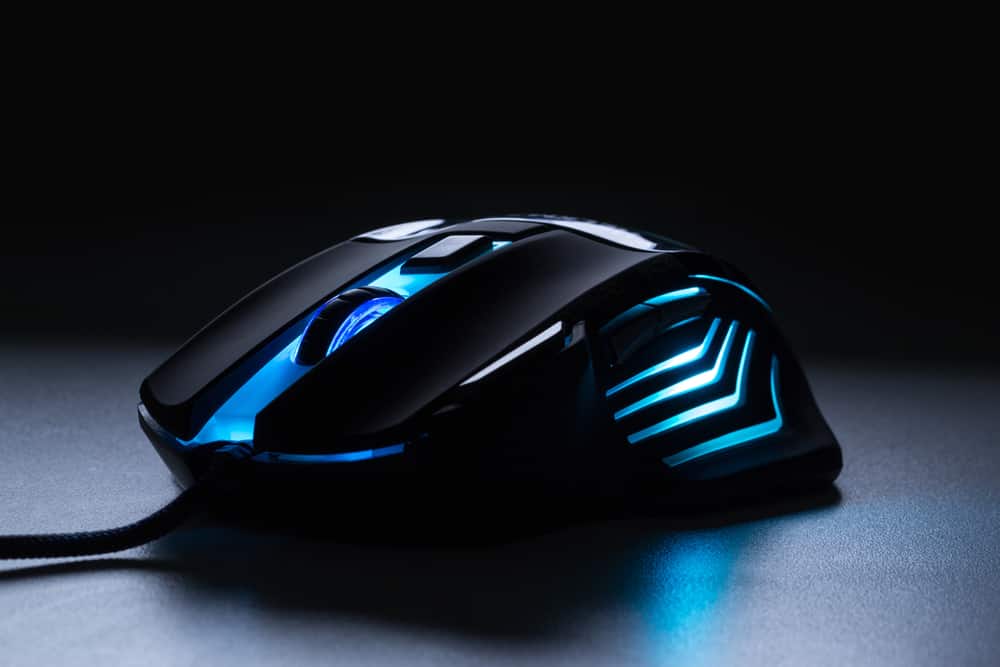
Computer mice are getting more advanced, with manufacturers competing to offer more functionalities.
You can find these functionalities as different buttons located on the mouse.
Your mouse may have buttons other than the scroll and left/right switches.
One of these buttons is the CPI, which can be confusing to the average user.
What Does CPI Button On A Mouse Do?

The CPI button on your mouse changes your mouse’s Counts Per Inch (CPI).
It’s the rate at which the mouse reports its movements to the computer.
More precisely, the CPI measurement determines how many pixels the pointer can travel on the screen for each physical movement of the mouse.
As such, it refers to the mouse’s sensitivity to physical movements.
For example, if the CPI is 500, the pointer moves for 500 pixels with each mouse movement.
The higher the CPI level, the higher the mouse’s sensitivity and ability to cover more pixels with shorter movements.
If the CPI level is low, you have to move the mouse further to cover a specific area on the screen.
As you increase CPI, this distance gets smaller.
The CPI button on the mouse allows you to raise or lower the mouse’s sensitivity and adjust it to your game requirements.
General-purpose mice don’t have a CPI button, so you’re more likely to find it on a gaming mouse.
Depending on the mouse’s design, the CPI button may be located in the center or on the sides of the mouse.
You should read the user manual to identify the CPI button and other buttons.
Is The CPI Button Necessary?

The CPI is a key feature of any mouse because it determines how fast the cursor moves across the screen when you move the mouse.
That’s a crucial feature, especially for gamers, because different games require different mouse sensitivity levels.
Even if you don’t play games, you should adjust your mouse’s sensitivity to a comfortable level that matches your activities.
If the mouse is too sensitive, you can’t control its movement as it zaps from one side of the screen to the other.
However, not every mouse has a CPI button.
You can mostly find such a button on gaming mice because gamers need to change CPI settings on the fly.
The mouse CPI button allows them to change their mouse sensitivity without leaving the game to go to its settings.
Regular users can change their mouse sensitivity through its dedicated settings in Windows or macOS.
How To Change CPI

If your mouse has a dedicated CPI button, you can easily change your CPI by pressing this button to cycle through the available options.
Depending on the mouse, you may have different speeds, but most mice have three options: Standard, Slow, and Fast.
You can also change these configurations through the mouse’s software.
Another way to change your mouse sensitivity is through the in-game settings.
Many games allow you to change the CPI inside the game so that you don’t have to exit the game to adjust these settings.
That’s a handy option if you’re a casual gamer but don’t have a gaming mouse.
If your mouse doesn’t have a dedicated button to change CPI, you can do so in Windows Mouse settings.
To do so, go to Windows Settings and select Devices.
Click Mouse on the left panel and move the slider under Cursor Speed.
As you move the toggle to the left and right, you can see the changes in the cursor’s speed.
Try different speeds to land on the point that feels most comfortable.
You can do the same on macOS.
Go to System Preferences and select Mouse > Point and Click.
In this section, you can see a slider under Tracking speed, which you can move to the left or right to change your mouse’s sensitivity.
What’s The Best CPI Value?

If you have a gaming mouse, its CPI can be as high as 2,000 and more.
Some gaming mice can have crazy CPI values that can reach up to 20,000.
If the CPI value is that high, does it mean you should use it?
Definitely not, because higher CPI and sensitivity don’t necessarily mean higher performance.
However, knowing the best CPI value can greatly affect your performance.
You may not need to know the exact CPI value if you’re not a gamer.
You just need to tweak the mouse sensitivity settings until you feel comfortable with the pointer speed.
However, gamers should know their CPI values because each game requires different pointer speeds.
If your mouse sensitivity is too high, you may end up missing pixels, having to go back and forth to hit specific targets.
This will negatively affect your performance and speed.
In addition, knowing the required CPI for different games will help you purchase the right gaming mouse since gaming mice have different CPI levels.
If you change your CPI values through Windows or Mac settings, you can find that the most comfortable value is the fifth or sixth notch on the slider.
Anything more than that will feel uncomfortable and uncontrollable.
For gaming mice, the value largely depends on the game, so you can find the best CPI setting for specific games by checking the recommended game settings.
For average users, the recommended CPI is 600–800, which is the default value on most mice.
For gaming, it depends on the game.
For example, FPS games don’t require more than 800CPI, while RPG and MMO games require a default value of 1,000–1,200, and you should increase it depending on the game.
What Affects CPI Values?

The best CPI values depend on factors other than game requirements.
One of them is your screen resolution.
The higher the screen resolution, the higher the number of pixels per inch.
As a result, you’ll need a higher sensitivity for your mouse.
The monitor size and style—whether it’s flat or curved—will also affect your mouse sensitivity.
That said, everything comes down to your personal preferences, which are affected by your muscle memory.
Computer users and gamers develop a muscle memory that automatically helps them move their wrists for different tasks.
Even if the game settings recommend a specific CPI value, you may not want to change it because you’re used to another value that works fine.
DPI Vs. CPI

If you check different gaming mice on the market, you can see that not all of them have the same buttons.
Plus, the buttons with the same functions may be labeled differently.
One of these labels is CPI vs. DPI.
What does DPI mean on a mouse?
Generally speaking, DPI and CPI are the same values that refer to the mouse’s sensitivity.
Technically speaking, DPI has nothing to do with mice.
Short for Dots Per Inch, DPI is a feature of printers, not mice.
Dots Per Inch refers to the ink density on an inch of paper.
DPI is a misnomer used in the gaming world, and many manufacturers use it to refer to CPI.
CPI Vs. Polling Rate

When checking a mouse’s specs, you’ll see another feature that can be as important as CPI: polling rate.
A mouse’s polling rate can be related to CPI and may confuse the average user.
Let’s explore the differences.
As mentioned, CPI (or DPI on some gaming mice) is the mouse pointer’s response level to the physical mouse movements.
On the other hand, the polling rate is frequency, measured in hertz.
It shows how often the mouse reports its location on the screen to the computer.
Also known as report rate, polling rate can affect your gaming performance because it can show the real-time location of the pointer in a matter of seconds.
Depending on the mouse brand and design, your polling rate can range from 125 to 1,000 Hz.
If your mouse’s polling rate is 250, it reports its location 250 times per second (once every four milliseconds).
The higher the number, the more accurate the location of your cursor, which can affect input lag and in-game precision.
However, like CPI, you don’t need crazy high polling rates because these values have negligible effects when they go over 1,000.
Therefore, anything higher than 1,000 is overkill.
You can adjust your polling rate through the mouse’s app, which can be differently phrased and located depending on the app.
Should You Reprogram The CPI Button?

The CPI button is a crucial component of gaming mice because it can determine your mouse’s sensitivity.
However, not everyone can benefit from this button.
If you’re not a serious gamer, you may find a golden spot that works for all your games, so you don’t need to change it for each game.
In other cases, the button is located in a spot that triggers inadvertent pushes.
If you constantly push the CPI accidentally, it can change your pointer speed and make things uncomfortable for you.
In such cases, you can reprogram the button and assign it a different function, provided that your mouse is programmable.
To do so, you can go to the mouse’s app and assign the button a function that you use frequently.
For example, if you listen to music a lot, you can use the button to pause music or adjust the volume.
NEXT: Are Keycaps Universal? (Explained)

























